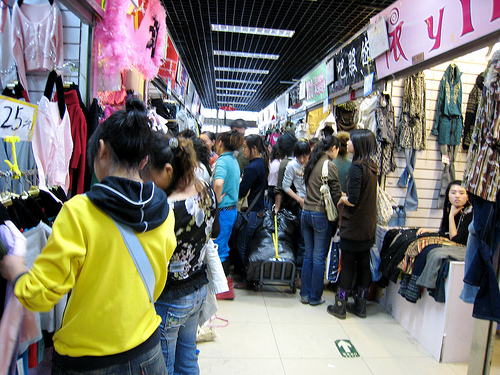 A Beijing friend of mine prefers to shop in Hong Kong, where clothes are cheaper than in Beijing. If you must shop for clothes in Beijing, she said, go to the Beijing Zoo. She meant a cluster of stores near the zoo.
A Beijing friend of mine prefers to shop in Hong Kong, where clothes are cheaper than in Beijing. If you must shop for clothes in Beijing, she said, go to the Beijing Zoo. She meant a cluster of stores near the zoo.
When the movie Titanic came out, and I knew it cost a lot to make, I thought I’d lose money if I didn’t buy a ticket to see it. For the first time since Titanic I had a similar feeling: At the Beijing Zoo prices were so low it felt like losing money if I didn’t buy something.
On seven floors there were hundreds of shops, each crammed with some clothing item: dresses, scarves, shoes, jackets, pants, shirts, and so on. More shoes than anything else. (Few socks.) I wanted to buy shirts but the shirt selection was poor, consistent with the fact that the shirts I already have are from Malaysia, the Philippines, and Hong Kong. But because I could buy a $6 shirt that would cost $80 in America, I bought a few anyway. I was happier with the shoes I bought ($10 here, $100 in America).
I love shopping (but alas dislike owning) and especially love Chinese shopping because the sticker price is often just a starting point. It is like adding spices to food. At the first shoe vendor, the quoted price for shoes I liked was $40. I got up to leave. What’s your lowest price? I asked. $30. I started to leave. What’s your price? she asked. What’s your lowest price? I repeated. As I left, the price went down to $20. That’s your lowest price? I asked. Yes, she said, what’s your price? That was helpful. With other vendors, I started at $7 and gradually increased my offers to $10, at which point they were accepted — but only if I was leaving. Sometimes the sticker price was the actual price. For a jacket advertised at about $14 I paid about $14, even though another stall a few feet away had the same thing. I went back and forth between the vendors and $14Â was the best I could do.
I hoped to buy a winter jacket but to my astonishment couldn’t find one I liked. The student store at Tsinghua has about five winter jackets for sale and I would happily buy one of them ($50). Among hundreds and hundreds of men’s winter jackets at Beijing Zoo I didn’t see a single one I liked. Good excuse to return . . .
 A Beijing friend of mine prefers to shop in Hong Kong, where clothes are cheaper than in Beijing. If you must shop for clothes in Beijing, she said, go to the Beijing Zoo. She meant a cluster of stores near the zoo.
A Beijing friend of mine prefers to shop in Hong Kong, where clothes are cheaper than in Beijing. If you must shop for clothes in Beijing, she said, go to the Beijing Zoo. She meant a cluster of stores near the zoo.